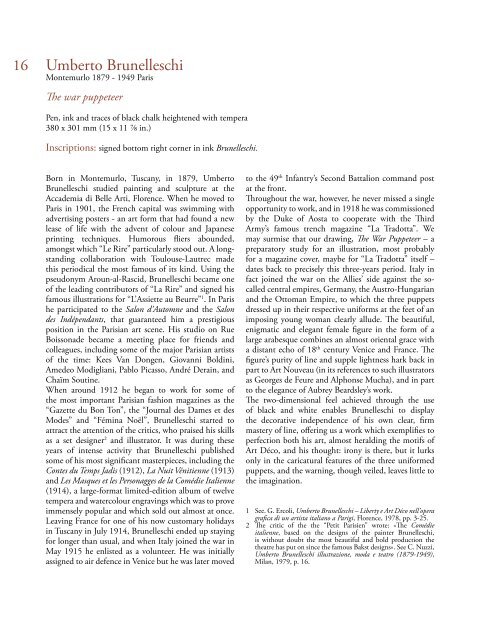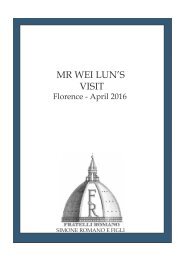A selection of master drawings 2016
- No tags were found...
Create successful ePaper yourself
Turn your PDF publications into a flip-book with our unique Google optimized e-Paper software.
16<br />
Umberto Brunelleschi<br />
Montemurlo 1879 - 1949 Paris<br />
The war puppeteer<br />
Pen, ink and traces <strong>of</strong> black chalk heightened with tempera<br />
380 x 301 mm (15 x 11 ⅞ in.)<br />
Inscriptions: signed bottom right corner in ink Brunelleschi.<br />
Born in Montemurlo, Tuscany, in 1879, Umberto<br />
Brunelleschi studied painting and sculpture at the<br />
Accademia di Belle Arti, Florence. When he moved to<br />
Paris in 1901, the French capital was swimming with<br />
advertising posters - an art form that had found a new<br />
lease <strong>of</strong> life with the advent <strong>of</strong> colour and Japanese<br />
printing techniques. Humorous fliers abounded,<br />
amongst which “Le Rire” particularly stood out. A longstanding<br />
collaboration with Toulouse-Lautrec made<br />
this periodical the most famous <strong>of</strong> its kind. Using the<br />
pseudonym Aroun-al-Rascid, Brunelleschi became one<br />
<strong>of</strong> the leading contributors <strong>of</strong> “La Rire” and signed his<br />
famous illustrations for “L’Assiette au Beurre” 1 . In Paris<br />
he participated to the Salon d’Automne and the Salon<br />
des Indépendants, that guaranteed him a prestigious<br />
position in the Parisian art scene. His studio on Rue<br />
Boissonade became a meeting place for friends and<br />
colleagues, including some <strong>of</strong> the major Parisian artists<br />
<strong>of</strong> the time: Kees Van Dongen, Giovanni Boldini,<br />
Amedeo Modigliani, Pablo Picasso, André Derain, and<br />
Chaïm Soutine.<br />
When around 1912 he began to work for some <strong>of</strong><br />
the most important Parisian fashion magazines as the<br />
“Gazette du Bon Ton”, the “Journal des Dames et des<br />
Modes” and “Fémina Noël”, Brunelleschi started to<br />
attract the attention <strong>of</strong> the critics, who praised his skills<br />
as a set designer 2 and illustrator. It was during these<br />
years <strong>of</strong> intense activity that Brunelleschi published<br />
some <strong>of</strong> his most significant <strong>master</strong>pieces, including the<br />
Contes du Temps Jadis (1912), La Nuit Vénitienne (1913)<br />
and Les Masques et les Personagges de la Comédie Italienne<br />
(1914), a large-format limited-edition album <strong>of</strong> twelve<br />
tempera and watercolour engravings which was to prove<br />
immensely popular and which sold out almost at once.<br />
Leaving France for one <strong>of</strong> his now customary holidays<br />
in Tuscany in July 1914, Brunelleschi ended up staying<br />
for longer than usual, and when Italy joined the war in<br />
May 1915 he enlisted as a volunteer. He was initially<br />
assigned to air defence in Venice but he was later moved<br />
to the 49 th Infantry’s Second Battalion command post<br />
at the front.<br />
Throughout the war, however, he never missed a single<br />
opportunity to work, and in 1918 he was commissioned<br />
by the Duke <strong>of</strong> Aosta to cooperate with the Third<br />
Army’s famous trench magazine “La Tradotta”. We<br />
may surmise that our drawing, The War Puppeteer – a<br />
preparatory study for an illustration, most probably<br />
for a magazine cover, maybe for “La Tradotta” itself –<br />
dates back to precisely this three-years period. Italy in<br />
fact joined the war on the Allies’ side against the socalled<br />
central empires, Germany, the Austro-Hungarian<br />
and the Ottoman Empire, to which the three puppets<br />
dressed up in their respective uniforms at the feet <strong>of</strong> an<br />
imposing young woman clearly allude. The beautiful,<br />
enigmatic and elegant female figure in the form <strong>of</strong> a<br />
large arabesque combines an almost oriental grace with<br />
a distant echo <strong>of</strong> 18 th century Venice and France. The<br />
figure’s purity <strong>of</strong> line and supple lightness hark back in<br />
part to Art Nouveau (in its references to such illustrators<br />
as Georges de Feure and Alphonse Mucha), and in part<br />
to the elegance <strong>of</strong> Aubrey Beardsley’s work.<br />
The two-dimensional feel achieved through the use<br />
<strong>of</strong> black and white enables Brunelleschi to display<br />
the decorative independence <strong>of</strong> his own clear, firm<br />
<strong>master</strong>y <strong>of</strong> line, <strong>of</strong>fering us a work which exemplifies to<br />
perfection both his art, almost heralding the motifs <strong>of</strong><br />
Art Déco, and his thought: irony is there, but it lurks<br />
only in the caricatural features <strong>of</strong> the three uniformed<br />
puppets, and the warning, though veiled, leaves little to<br />
the imagination.<br />
1 See. G. Ercoli, Umberto Brunelleschi – Liberty e Art Déco nell’opera<br />
grafica di un artista italiano a Parigi, Florence, 1978, pp. 3-25.<br />
2 The critic <strong>of</strong> the the “Petit Parisien” wrote: «The Comédie<br />
italienne, based on the designs <strong>of</strong> the painter Brunelleschi,<br />
is without doubt the most beautiful and bold production the<br />
theatre has put on since the famous Bakst designs». See C. Nuzzi,<br />
Umberto Brunelleschi illustrazione, moda e teatro (1879-1949),<br />
Milan, 1979, p. 16.





